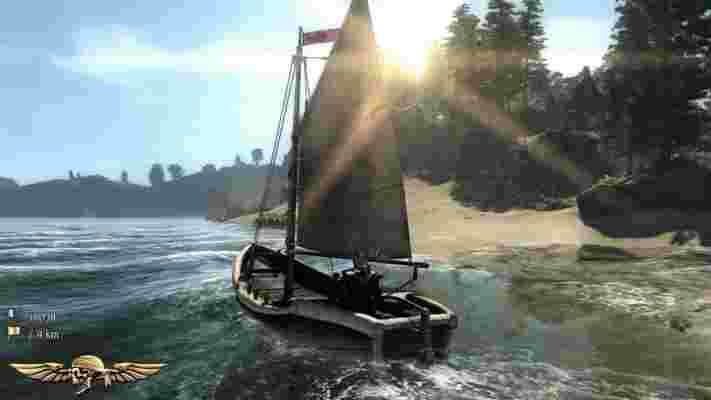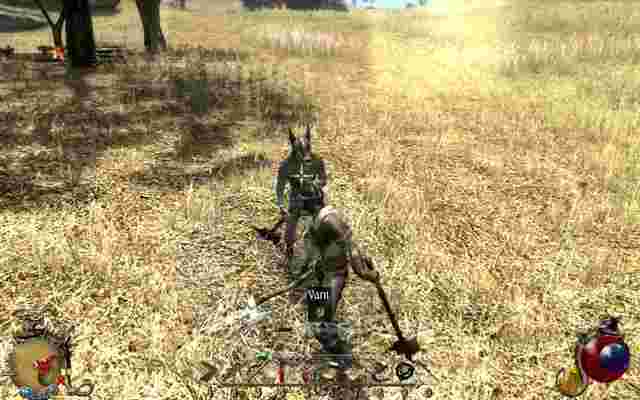When a game suffers fumble after fumble, it’s easy to overlook any good qualities that may have graced it. Two Worlds II is one such game, and it’s a real shame. While its prequel is the butt of many a joke (namely for its game-breaking bugs, lackluster plot, shoddy voicework, and uninspired quests), Two Worlds II, while leaps and bounds more sophisticated a title, sadly did not fare much better under the public’s scrutiny.

This is such an unfortunate outcome because, while there are certainly flaws to this game, there’s also kernels of something really special if you sift through it with a wide enough net.
Graphics

For every success, there’s a failure immediately following. The most obvious example of this is the game’s overall aesthetic. Character models are surprisingly polished for a game that came out in 2011 (the same year as Bethesda’s similarly-themed Elder Scrolls V: Skyrim), and in some ways perhaps are even better looking. Environment art and lighting are gorgeous, ranging from the wilds of the Savannah to islands, to bustling cities, to the nightmarish Swallows of act two. It all looks great until you start trying to make your way through it.

To call the animations ‘clunky’ would be charitable. Sprinting is difficult to control and looks awkward, melee swings are jittery and unwieldy , and archery seems to lack any real punch on impact. On top of all that, the rendering of it all is slow, especially with a character’s hair and armor. For all the immersion that comes with a game that looks this good, poor rendering will pull the player right back out again.
Exploration
The few people who did like the original Two Worlds are quick to point out the game’s outstanding sense of wanderlust. While there was a (loosely) story-driven narrative, the distance spanning from plot point to plot point was immense and rife with powerful enemies. Players relied on the sparse and expensive teleport platforms to travel distances quickly, or maybe stumble upon the rare horse if they were lucky. The result was that going from point A to point B really wasn’t an option, and it all created a very special sense of long trekking and exploring every bend and gully.
Needless to say, these fans who did move to Two Worlds II were sorely disappointed to find that the wanderlust element was far reduced. Not to say that the game is a corridor – far from it – but there are definitely distinct areas that you won’t be able to reach until certain plot points are fulfilled. The map doesn’t make that very intuitive, either, crammed with markers and quests that are difficult to navigate or distinguish between.
Plot
The plot of Two Worlds II starts off strong, with a good old-fashioned prison break. The player character is rescued with little explanation by a team of orcs. The abundance of dialogue in the prologue is deceptive, misleading us into believing we are in for a game with rich recurring characters or perhaps even NPC followers. The prologue alone introduces a rogue, a mage, a ranger, a blacksmith, a fighter, and a prophet – all of whom feel like they’d be tied pretty tightly to the story. This is not the case.
After the prologue is complete, there’s hardly any reason to speak with these characters again, which is sad since they were well-written and well voice-acted. It’s almost like the lead writer finished the first act and then wiped his hands of it and handed it off to someone with a vastly different idea. On top of all that, the story is based around you saving your sister, Kyra, even though the entirety of the first game revolved around the same thing. But maybe that isn’t fair to complain about, judging by popularity of rescue-the-princess titles like Legend of Zelda or Mario …
So for all of these complaints, what are this game’s uniquely good qualities?
Why play solo when you can be a fellowship?
While not the only game of this niche to attempt multiplayer, this one does a surprisingly good job of it. There’s a PvP mode, a village building simulator, a Crystal Capture game, and best of all a team-oriented dungeon crawl called Adventure Mode . Here up to eight players can work together fighting through seven different (albeit linear) maps. When you have a handful of low-level players all spelunking through the same cave, you’re in for a good time. Because the game features such a variety of builds, it can actually be quite conducive to strong teamwork and strategy. Mages can buff other players, turning the party invisible with an AoE spell, or even resurrecting players that die nearby. Rogues can use distraction arrows or ice arrows to thin the herd. Warriors can use powerful flurries and counterattacks to make short work of even the mightiest of monsters. If you let yourself get immersed in the team roleplay, the game will make it worth your while.
Spells are only limited by your imagination … and your character’s wallet.
Perhaps the greatest feature of this game, the magic system is where Two Worlds II really shines. While most games will let you spend perks to unlock new spells and powers, this game takes a different approach. Rather than give players the recipe for each spell, Two Worlds II instead merely gives the players the ingredients. Spells are divided into water, air, fire, earth, and necromancy, then further subdivided (ie fire yields fire, power, and force). A carrier is then added to your spell to determine how it manifests, be it a missile, a summon, monolith or trap. Lastly, you can tag on a modifier to include things like homing, ricochet, spray, damage over time, or protection. In this game, if you can think it, you can probably craft a spell to do it. Magic serves as your back door to solving really every puzzle, provided you’re talented and creative enough to make the spell , and that’s a really cool feeling. Magic that is used to wipe out hordes of zombies and rain meteors can just as easily be used to open locks, walk on water, or levitate. If you want to see just how crazy this can get, check out these videos:
Invest in any skills you want
When you level up in Two Worlds II, you are never constrained to any one avenue of gameplay. Players who’ve been allocating perks for warrior can just as easily start spending those points on magic or ranger abilities if they want to branch out. While this isn’t a wholly unique concept (you can just as easily find this is a game like Skyrim or Path of Exile, or even the first Two Worlds), we were grateful that it was included here as well. For a hefty price, Soulpatchers can also allow you to redistribute your skills if you decide you made a mistake. The end result is that there’s plenty of room for error, or on the flip side you may intentionally put those points into mage skills once you’ve collected enough cards to make it worth the shift. It’s up to player choice, and that’s always a good thing.
You can be a bard.
Anybody who has played Witcher 3 can tell you how addicting a good mini-game can be. There’s a reason Gwent became a standalone game! Two Worlds II has a dice high-low simulator, a dice-based poker game, a clever pickpocketing mechanic, and – best of all – a full-fledged busking system. Players who find a flute or a harp can take advantage of a mini-game reminiscent of Guitar Hero. Get good enough at it, find yourself a busy throng of people in a marketplace, and suddenly you’re earning auras (the game’s currency) enough to purchase that heavy plate mail you had your eye on. You can collect or purchase new music for different instruments, and – surprise of all surprises – if you and another player in multiplayer time it just right you can actually play the full song !
In the end, Two Worlds II is undeniably a flawed game. It pushed the envelope in many avenues where the first game laughably failed, but still doesn’t really compare with the wildly successful Elder Scrolls, Dragon Age, or Witcher. But that’s the beauty here – it isn’t those games. Two Worlds II succeeds in other areas, and frankly, we wonder what a game like Skyrim would be like if it did try to emulate the magic system of Two Worlds II, or what Witcher would be like if it incorporated a pickpocketing mechanic. If you’re willing to look past the game’s faults, you might be surprised to find you wish more fantasy RPGs did share these elements from Two Worlds II.
We’re looking forward to Two Worlds III, and hope that they can get the core mechanics ironed out enough that all the uniquely special aspects that this franchise possesses can really shine through next round.
More from Softonic
5 incredible multiplayer games for iOS and Android
The 10 best free to play games ever
10 best action games for your bucket list
Best video games to play with a partner
